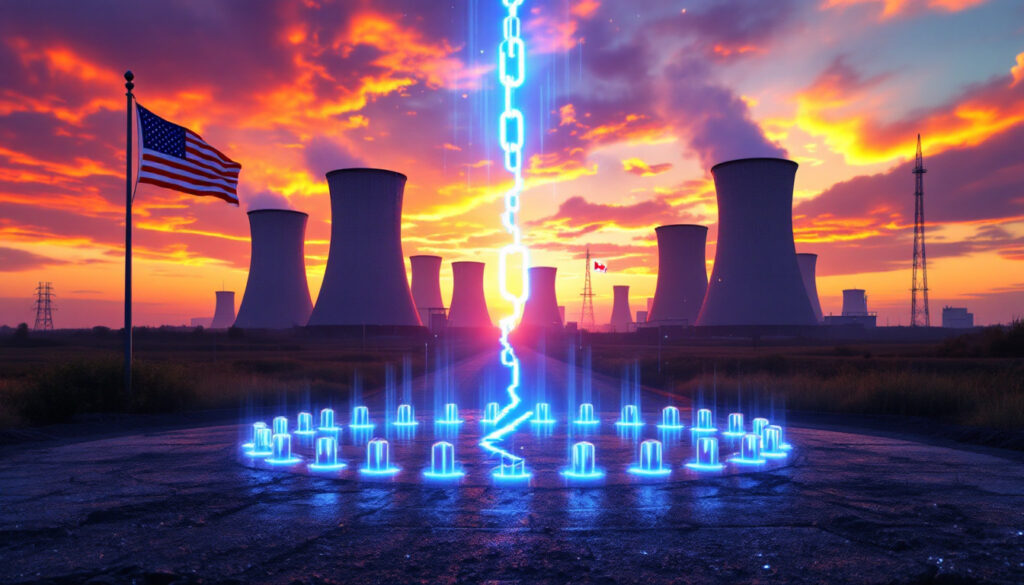US Uranium Market Faces Disruption Amid Tariff Threats: Understanding the Impact
The US uranium market is experiencing unprecedented turbulence as tariff threats cast a shadow over the nuclear fuel supply chain. With the United States relying on imports for 95% of its uranium needs, proposed tariffs on Canadian energy exports have sent shockwaves through the industry. This uncertainty comes at a critical time when nuclear power is increasingly viewed as essential for meeting carbon reduction goals while maintaining baseload power generation capacity. Understanding the implications requires a comprehensive guide to global uranium production to put these developments in context.
How Are Tariff Threats Affecting the US Uranium Market?
Current Market Slowdown
US nuclear power companies have dramatically scaled back uranium purchases and new contracts due to looming tariff threats, creating what industry experts describe as "complete paralysis" in the market. According to data from TradeTech, US utility purchases have plummeted by 50% compared to typical contracting volumes, representing a potential shortfall of over 20 million pounds of uranium.
"There are too many 'what-if' scenarios creating complete paralysis in the market," explains John Ciampaglia, CEO of Sprott Asset Management, a firm specializing in uranium investments. This sentiment reflects the broader uncertainty permeating throughout the industry.
Nuclear operators, which typically secure fuel through long-term contracts spanning 5-10 years, have adopted a wait-and-see approach. Industry data shows uranium spot prices surging from $42/lb in December 2024 to approximately $52/lb by March 2025 following tariff announcements, highlighting the immediate market response to potential supply disruptions.
Jonathan Hinze, president of uranium market research firm UxC, confirmed this trend: "Utilities are currently relatively inactive on the contracting front," as procurement departments calculate potential cost implications of a 10% tariff on their fuel expenses. These developments are part of a larger pattern of how Trump's policies are reshaping global commodity markets beyond just uranium.
US Nuclear Sector Dependency on Imports
With 94 operational nuclear reactors consuming approximately 47 million pounds of uranium annually, the United States maintains its position as the world's largest uranium buyer. Yet domestic production remains minimal—roughly 200,000 pounds in 2024 according to Energy Information Administration data—creating a 95% dependency on foreign sources.
Canada supplies more than 25% of US uranium needs, making it the largest single provider. Other major suppliers include Kazakhstan (22%), Russia (16%), and Australia (11%), according to the 2024 World Nuclear Association report. This international supply chain now faces significant disruption with the proposed 10% levy on Canadian energy exports, including uranium.
Pre-tariff data shows US imports from Canada averaged 12-15 million pounds annually between 2020-2024. Analysts estimate the proposed tariff could increase annual fuel costs for US utilities by $150-$200 million, potentially affecting consumer electricity rates in regions heavily dependent on nuclear power.
The Department of Energy's 2024 annual uranium report emphasized that diversifying critical minerals supply chains is critical to energy security, highlighting the vulnerability created by overreliance on imports, particularly from geopolitically sensitive regions like Kazakhstan and Russia.
What Are the Immediate Risks to US Nuclear Operations?
Supply Chain Vulnerabilities
The uranium market faces mounting uncertainty regarding the scope and duration of levies scheduled to begin April 2, 2025. This regulatory ambiguity has created significant market dislocation as buyers remain hesitant to commit to new contracts.
A critical concern involves fuel assembly lead times, which typically require 18-24 months from order to delivery. This extended procurement cycle means current purchasing decisions directly impact reactor operations in 2026-2027, when fuel shortages could potentially materialize if contracting paralysis continues.
"Utilities are waiting to see what this all means before they take action," explains Karen Radosevich, nuclear fuel supply manager at Entergy, which operates four reactors across Arkansas, Mississippi, and Louisiana. The company has accelerated deliveries following the tariff implementation delay, a strategy being replicated by other proactive utilities.
Recent logistical challenges have compounded these concerns. Canadian rail strikes in February 2025 reportedly delayed 1.2 million pounds of uranium destined for US reactors, demonstrating the vulnerability of just-in-time delivery systems. Industry experts note that such disruptions could become more common as suppliers and utilities adjust to new market dynamics.
Industry Response to Tariff Threats
Nuclear operators have implemented divergent strategies to navigate tariff uncertainty. While some remain cautious, others have moved aggressively to secure supplies ahead of potential price increases. This situation is particularly challenging when navigating US tariff risks in commodity markets more broadly.
Entergy has emerged as an industry leader in adapting to these challenges, accelerating deliveries and securing approximately 2.5 million pounds from Canadian supplier Cameco in January 2025. Similarly, Georgia's Vogtle Plant reportedly increased planned 2025 deliveries by 40% to preempt tariff implementation.
The Nuclear Energy Institute (NEI) has warned that "regulatory uncertainty complicates emergency procurement," highlighting the industry's complex purchasing requirements. Mid-2025 contract bids have already risen 18% year-over-year as utilities hedge against future supply constraints, according to industry procurement data.
Uranium enrichment services represent another vulnerability, as only 20% of US uranium is enriched domestically, with the remaining 80% processed at European and Russian facilities. This multi-stage international supply chain creates additional complications for utilities attempting to mitigate tariff impacts.
What Is the Long-Term Outlook for US Uranium Supply?
Current Inventory Levels
Despite immediate market disruptions, US reactors are not facing imminent fuel shortages. "Utilities have adequate supplies for 2025 and most of 2026," confirms Grant Isaac, CFO of Cameco, North America's largest uranium producer. Industry averages suggest utility stockpiles typically cover 24-30 months of operations, providing a temporary buffer against supply disruptions.
However, the Department of Energy Advisory Board cautions that "inventories mask short-term risks, not long-term systemic gaps." With approximately 45% of US nuclear plants scheduled for refueling in 2026, continued procurement delays could eventually impact operational readiness, particularly for reactors with below-average inventory levels.
The strategic uranium reserve maintained by the Department of Energy—approximately 60 million pounds—provides additional security, though accessing these stockpiles requires regulatory approval and typically serves as a measure of last resort during supply emergencies.
Strategic Considerations for Nuclear Operators
US utilities are increasingly exploring domestic uranium resources as a long-term hedge against import vulnerabilities. Wyoming and Texas contain approximately 85% of US uranium reserves, with in-situ recovery (ISR) methods offering the most economical extraction approach. Industry projections suggest domestic production could potentially increase from 200,000 pounds to 2 million pounds annually by 2030, though this represents only a fraction of total demand.
The Nuclear Energy Institute projects that domestic uranium mining revitalization would require sustained uranium prices above $65 per pound to incentivize investment in new production. Recent permit approvals for 12 new uranium mines in Wyoming signal growing interest in rebuilding domestic capacity, though regulatory and environmental challenges persist.
"A $3 billion investment is needed to revive conversion and enrichment infrastructure," according to the Department of Energy's 2025 Nuclear Fuel Supply Roadmap. These downstream processes represent critical bottlenecks in the fuel supply chain that cannot be resolved through mining expansion alone.
Additionally, emerging technologies like small modular reactors (SMRs) and advanced reactor designs are projected to increase annual uranium demand by approximately 10% post-2030. TerraPower's CEO has highlighted that "advanced reactors require High-Assay Low-Enriched Uranium (HALEU) fuel, complicating supply chains" due to limited global production capacity for this specialized fuel form. These challenges are part of the broader issue of navigating the critical minerals race amid global tensions that affects many strategic resources.
According to Bloomberg News, the uranium market freeze has sent ripples throughout the global supply chain, with buyers worldwide reconsidering their procurement strategies in light of US policy shifts.
FAQ: US Uranium Market and Tariff Threats
How dependent is the US on imported uranium?
The US sources 95% of its nuclear fuel from abroad, with Canada providing more than 25% of the total uranium supply needed for the country's 94 nuclear reactors. Other major suppliers include Kazakhstan (22%), Russia (16%), and Australia (11%).
What is the proposed tariff on Canadian uranium?
The proposed tariff is a 10% levy on Canadian energy exports, including uranium, scheduled to begin on April 2, 2025. This would apply to both uranium concentrate (yellowcake) and uranium dioxide (UO₂) conversion services from Canada. Sprott's uranium report indicates this could significantly reshape global uranium trade patterns.
Are US nuclear plants at risk of running out of fuel?
According to industry experts, US reactors are not in immediate danger of a fuel shortage. Cameco CFO Grant Isaac has stated that utilities have adequate supplies for 2025 and most of 2026. However, continued procurement delays could create operational challenges by late 2026, particularly for plants with below-average inventories.
How has the market responded to the tariff threats?
The uranium market has experienced a significant slowdown, with US utility purchases dropping by 50% according to TradeTech data. Industry executives describe the situation as "complete paralysis" as buyers wait for clarity. Uranium spot prices have risen approximately 24% since the tariff announcement, reflecting market uncertainty and hedging behavior.
Want to Stay Ahead of Major Mineral Discoveries?
Discover opportunities in volatile markets like uranium with Discovery Alert's proprietary Discovery IQ model that delivers instant notifications on significant ASX mineral discoveries. Explore our discoveries page to understand how timely information on major mineral finds can generate substantial returns for savvy investors.




